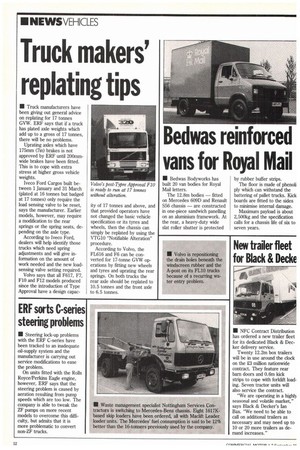Truck makers' replating tips
Page 8

If you've noticed an error in this article please click here to report it so we can fix it.
• Truck manufacturers have been giving out general advice on replating for 17 tonnes GVW. ERF says that if a truck has plated axle weights which add up to a gross of 17 tonnes, there will be no problems.
Uprating axles which have 175mm (7in) brakes is not approved by ERF until 200nunwide brakes have been fitted. This is to cope with extra stress at higher gross vehicle weights.
Iveco Ford Cargos built between 1 January and 31 March (plated at 16 tonnes but badged at 17 tonnes) only require the load sensing valve to be reset, says the manufacturer. Earlier models, however, may require a modification to the rear springs or the spring seats, depending on the axle type.
According to Iveco Ford, dealers will help identify those trucks which need spring adjustments and will give information on the amount of work needed and the new loadsensing valve setting required.
Volvo says that all F617, F7, F10 and F12 models produced since the introduction of Type Approval have a design capac ity of 17 tonnes and above, and that provided operators have not changed the basic vehicle specification or its tyres and wheels, then the chassis can simply be replated by using the VTG10 "Notifiable Alteration" procedure.
According to Volvo, the FL616 and F6 can be converted for 17-tonne GVW operations by fitting new wheels and tyres and uprating the rear springs. On both trucks the rear axle should be replated to 10.5 tonnes and the front axle to 6.5 tonnes.
















































